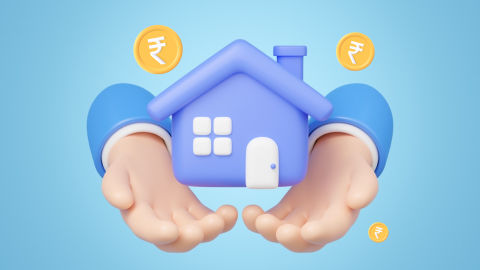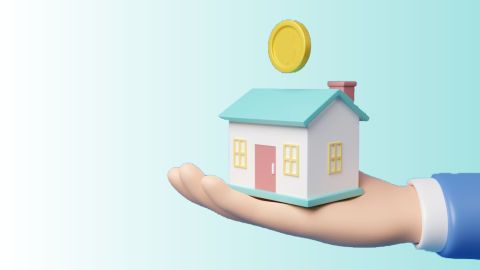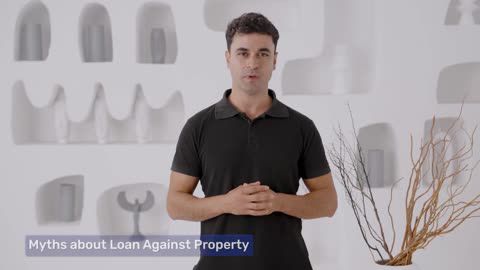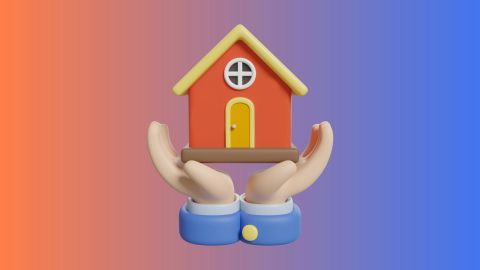A reverse mortgage is a financial product crafted for homeowners, typically seniors, to convert a portion of their home equity into cash without relinquishing ownership of the property. Unlike traditional mortgages, where the borrower makes monthly payments to the lender, a reverse mortgage allows homeowners to receive payments from the lender, effectively reversing the payment flow. Senior citizens aged 60 and above can leverage the equity value of their residential property to access funds through this loan facility.
How does a reverse mortgage loan work?
The initial principal limit available to a borrower is determined based on various factors, including the current market value of the property, the borrower’s age, the interest rate charged, and the lender’s margin.
For instance, if a residential property valued at Rs. 1 crore is utilised for reverse mortgage funding with a lender's margin of 20% and a loan tenure of 20 years, the initial principal limit would be calculated as the property’s market value less the lender’s margin, resulting in an amount of Rs. 80 lakh. This amount includes the total payment made to the borrower along with all lender charges like interest and processing fees. Borrowers can choose to receive this financial assistance either as a lump sum or periodically, such as monthly, quarterly, half-yearly, or yearly payments.
Unlike traditional mortgages, a reverse mortgage loan does not create an immediate liability on borrowers. Lenders initiate loan recovery only after the borrower permanently ceases to reside in the property, decides to sell it, or upon their demise. This unique loan structure offers senior citizens a source of income while allowing them to retain ownership and occupancy of their homes throughout their lifetime.
What are the 3 types of reverse mortgages?
The 3 types of reverse mortgages are home equity conversion mortgages (HECMs), proprietary reverse mortgages, and single-purpose reverse mortgages.
1. Home equity conversion mortgages (HECMs)
- HECMs are the most common type of reverse mortgage.
- They offer flexible payment options, allowing borrowers to receive funds as a lump sum, line of credit, monthly payments, or a combination thereof.
- HECMs have borrowing limits based on the appraised value of the home and the age of the youngest borrower.
- Borrowers must meet certain eligibility requirements, including attending counselling sessions and maintaining the property as their primary residence.
2. Proprietary reverse mortgages
- Proprietary reverse mortgages are offered by private lenders and are not insured by the FHA.
- They are designed for homeowners with higher home values and may offer larger loan amounts than HECMs.
- Proprietary reverse mortgages often have fewer restrictions on how funds can be used and may provide more flexible payment options.
- Borrowers must meet the lender's eligibility criteria, which may include minimum credit score requirements and property value thresholds.
3. Single-purpose reverse mortgages
- Single-purpose reverse mortgages are typically offered by state or local government agencies or nonprofit organisations.
- They are designed for specific purposes, such as home repairs, property taxes, or home improvements.
- Single-purpose reverse mortgages often have lower costs and may be available to borrowers with lower income or credit scores.
- Funds from a single-purpose reverse mortgage can only be used for the specified purpose outlined in the loan agreement.
Choosing the right type of reverse mortgage
When considering a reverse mortgage, it is essential to carefully evaluate your financial situation, goals, and preferences to determine the most suitable option.
Consider factors such as your age, home value, income needs, and long-term financial objectives when selecting the type of reverse mortgage that best fits your circumstances.
Consult with a qualified financial adviser or reverse mortgage counsellor to explore your options, understand the implications of each type of reverse mortgage, and make informed decisions about your retirement planning strategy.
How to obtain a reverse mortgage loan?
A reverse mortgage loan presents a unique financial option tailored specifically for senior citizens. Upon securing this loan, borrowers are relieved from the obligation of making monthly payments. Instead, individuals must mortgage their residential property to access the funds.
Repayment is not required on a monthly basis; it only becomes due after the borrower sells the property, vacates it, or passes away. With a reverse mortgage loan in India, borrowers have the flexibility to receive the loan amount in various forms, including monthly payments, lump sums, or a line of credit, catering to their diverse financial needs.
To determine the sanctioned credit amount for a reverse mortgage, the value of the mortgaged property is considered. It is essential to keep all necessary documents handy when applying for this loan.
Alternatively, individuals can explore Bajaj Finserv Loan Against Property, offering a competitive interest rate and other charges. This loan allows borrowers to leverage the equity in their residential properties for financing needs. With easy eligibility criteria and documentation requirements, applicants can access high loan amounts of up to Rs. 30 crore*.
Moreover, Bajaj Finserv Loan Against Property offers various features, including hassle-free disbursal, balance transfer options, high-value top-up loans, and online account management. The application process is straightforward, with quick approval and disbursal.




